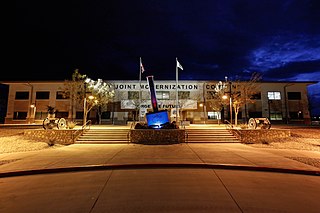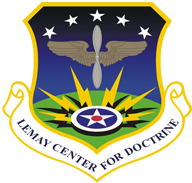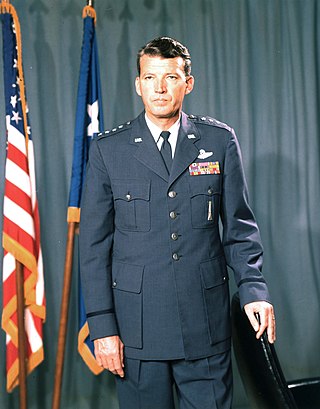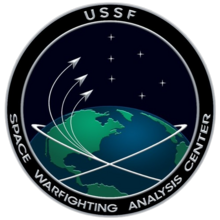The United States Armed Forces are the military forces of the United States. The armed forces consists of six service branches: the Army, Marine Corps, Navy, Air Force, Space Force, and Coast Guard. All six armed services are among the eight uniformed services of the United States.

North American Aerospace Defense Command, known until March 1981 as the North American Air Defense Command, is a combined organization of the United States and Canada that provides aerospace warning, air sovereignty, and protection for Canada and the continental United States.

ISTAR stands for intelligence, surveillance, target acquisition, and reconnaissance. In its macroscopic sense, ISTAR is a practice that links several battlefield functions together to assist a combat force in employing its sensors and managing the information they gather.

The United States Space Command is a unified combatant command of the United States Department of Defense, responsible for military operations in outer space, specifically all operations 100 kilometers and greater above mean sea level. U.S. Space Command is responsible for the operational employment of space forces that are provided by the uniformed services of the Department of Defense.

The United States Army Space and Missile Defense Command (USASMDC) is an Army Service Component Command (ASCC) of the United States Army. The command was established in 1997. The current USASMDC commander is Lieutenant General Daniel L. Karbler with Senior Enlisted Advisor Command Sergeant Major John W. Foley.

The United States Strategic Command (USSTRATCOM) is one of the eleven unified combatant commands in the United States Department of Defense. Headquartered at Offutt Air Force Base, Nebraska, USSTRATCOM is responsible for strategic nuclear deterrence, global strike, and operating the Defense Department's Global Information Grid. It also provides a host of capabilities to support the other combatant commands, including integrated missile defense; and global command, control, communications, computers, intelligence, surveillance, and reconnaissance (C4ISR). This command exists to give "national leadership a unified resource for greater understanding of specific threats around the world and the means to respond to those threats rapidly".

Buckley Space Force Base is a United States Space Force base in Aurora, Colorado named after United States Army Air Service First Lieutenant John Harold Buckley. The base is run by Space Base Delta 2, with major units including the U.S. Space Force's Space Delta 4, the Colorado Air National Guard's 140th Wing, the Denver Naval Operations Support Center, and the National Reconnaissance Office's Aerospace Data Facility-Colorado.

The Research and Analysis Center (TRAC), formerly the TRADOC Analysis Center, is an analysis agency of the United States Army. TRAC conducts research on potential military operations worldwide to inform decisions about the most challenging issues facing the Army and the Department of Defense (DoD). TRAC relies upon the intellectual capital of a highly skilled workforce of military and civilian personnel to execute its mission.

The reorganization plan of the United States Army is a modernization (2015–2028) and reorganization (2006–2016) plan of the United States Army implemented (2006–2016) under the direction of Brigade Modernization Command. This effort formally began in 2006 when General Peter Schoomaker was given the support to move the Army from its Cold War divisional orientation to a full-spectrum capability with fully manned, equipped and trained brigades; this effort was completed by the end of 2016. It has been the most comprehensive reorganization since World War II and included modular combat brigades, support brigades, and command headquarters, as well as rebalancing the active and reserve components. The plan was first proposed by the Army's 34th Chief of Staff, Eric Shinseki, in 1999, but was bitterly opposed internally by the Army.

The U.S. Army Joint Modernization Command, or JMC, based in Fort Bliss, Texas, gains insights from "Fight Tonight" units about future ways of fighting, future technology, and force structure during realistic live, constructive, and/or simulated training exercises. Joint Modernization Command is subordinate to the Army Futures & Concepts Center in Joint Base Langley-Eustis, Virginia; both report to the U.S. Army's newest Four-Star Command, the Army Futures Command (AFC) based in Austin, Texas.

The Curtis E. LeMay Center for Doctrine Development and Education

John William Raymond is a retired United States Space Force general who served as the first chief of space operations from 2019 to 2022. The first guardian, he served as commander of the United States Space Command from 2019 to 2020.

The United States Army Futures Command (AFC) is a United States Army command that runs modernization projects. It is headquartered in Austin, Texas.

The chief of space operations (CSO) is the service chief of the United States Space Force. The CSO is the principal military adviser to the secretary of the Air Force for Space Force operations and, as a member of the Joint Chiefs of Staff, a military adviser to the National Security Council, the secretary of defense, and the president. The CSO is a statutory office held by a Space Force general, who is typically the highest-ranking officer on active duty in the Space Force.

The United States Space Force is organized by different units: the Space Staff, the field commands, and the space deltas.

While the United States Space Force gained its independence on 20 December 2019, the history of the United States Space Force can be traced back to the beginnings of the military space program following the conclusion of the Second World War in 1945. Early military space development was begun within the United States Army Air Forces by General Henry H. Arnold, who identified space as a crucial military arena decades before the first spaceflight. Gaining its independence from the Army on 18 September 1947, the United States Air Force began development of military space and ballistic missile programs, while also competing with the United States Army and United States Navy for the space mission.

The Space Development Agency (SDA) is a United States Space Force direct-reporting unit tasked with deploying disruptive space technology. A primary focus is space-based missile defense using large global satellite constellations made up of industry-procured low-cost satellites. The SDA has been managed by the United States Space Force since October 2022. By September 2023 the SDA had 23 satellites on orbit. SDA targets to have at least 1,000 satellites in low Earth orbit by 2026.

Space Delta 18 is a United States Space Force unit that serves as the National Space Intelligence Center (NSIC). It is headquartered at Wright-Patterson Air Force Base, Ohio and activated on 24 June 2022.

Brian David Sidari is a United States Space Force brigadier general who serves as the director of intelligence of the United States Space Command. A career intelligence officer, he has commanded 6th Intelligence Squadron and previously served as vice commander of the 480th Intelligence, Surveillance, and Reconnaissance Wing.
Joint All-Domain Command and Control or JADC2 is the concept that the Department of Defense has developed to connect sensors from all branches of the armed forces into a § unified network powered by artificial intelligence. These branches include the Air Force, Army, Marine Corps, and Navy, as well as Space Force.





















